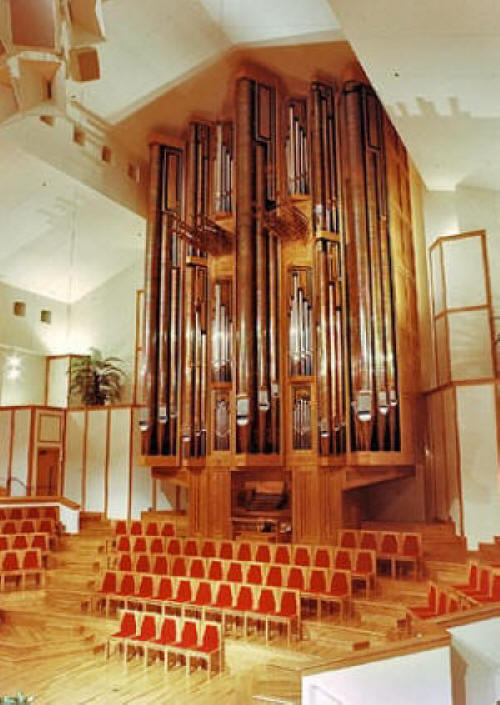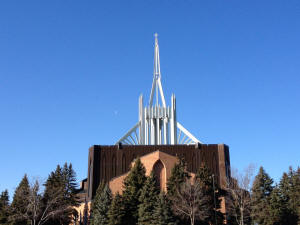|
The Church History
In 1943, an organizational meeting led to a Sunday School and
morning and evening church services on April 12, 1943. The
congregation adopted the name "The Wayside Chapel". During the early
months of 1949 plans were laid for the reorganization as a Baptist
church and a move to the Richfield American Legion Hall for
meetings. On June 12, 1949, a service was held at Bethlehem Baptist
Church of Minneapolis to officially organize the Richfield church as
Wooddale Baptist Church of Richfield. Later in the same month the
church broke ground for a permanent church building in the form of a
basement structure which was occupied November 13, 1949.
A $100,000 education unit and gymnasium/auditorium was completed for
dedication on September 13, 1959. Once again, in 1962, the church
began having duplicate Sunday morning services and began planning
for further expansion of the facilities. On September 27, 1964, the
first service was held in a new church auditorium.
In 1981, the church purchased 32 acres of undeveloped land in Eden
Prairie, Minnesota. Plans were drawn and finances were arranged in
anticipation of the nine-mile (14 km) move. Partially in response to
the results of a marketing study, the church was renamed "Wooddale
Church".
Construction began in fall of 1983 and the first phase of the new
campus (a multi-purpose worship room, administrative offices and
classrooms) was occupied in July of 1984. Plans and construction
were begun shortly thereafter on the second phase (gymnasium and
athletic complex, more classrooms, and more offices and workroom
area). The second phase was occupied in November of 1985.
Ground was broken for the 63,000 square-foot (5,853 square-meter)
Worship Center on October 30, 1988. The building was designed by
architect Bentz Thompson Rietow. Construction continued throughout
the winter of 1989 and occupancy of the 2000-seat worship center,
complete with pipe organ and a 200-foot (61-meter) steeple, was in
November of 1990.
During the summer of 1991, the lower level of the Worship Center,
consisting primarily of classrooms and music offices and rehearsal
room was completed. In the spring of 1995, construction again began
on the Wooddale Church campus to add further classroom space and
expand the offices. Work was completed in the fall of 1995.
On May 17, 1999, groundbreaking took place to provide a 34,600
square-foot (3,214 square-meter) addition that will be dedicated on
March 11 and 12, 2000. This new construction included a large,
modern nursery, an expanded bookstore, a new prayer room, a new
Chapel, more classroom space for adult and children's classes, and
an expanded kitchen and Wooddale Cafe.
The pipe organ at Wooddale Church, one of the largest tracker organs
in North America, while having its roots firmly based in European
organ design, also combines other elements to create an instrument
which is distinctly American. The wide variety and large number of
stops on the organ serve to make this instrument ideal for service
playing and concert use.
Visually, the instrument is designed using classical 18th century
Dutch principles of balance and symmetry. Subtle symbolism is also
present. Flamed copper pipes from the 32' Prinzipal stop are
arranged in three large towers to represent the Trinity. The center
tower and the copper horizontal trumpets serve to form a huge cross
which is outlined by the surrounding tin pipes of the Kronpositiv
8'. The horizontal trumpets also symbolize victory over the cross.
The stops of the organ, which are labeled in German to point out yet
another of the many backgrounds drawn upon to create this
instrument, can be divided into four families of pipes:
The Principal stops form the tonal background
of the organ. These pipes,which range in size from the huge copper
facades to pipes inside the organ much smaller than a pencil, cover
the entire spectrum of human hearing. Some pitches are felt more
than they are heard. Together these seets of pipes give the organ
its rich and broad tone character.
Flute stops are also abundantly present in this
instrument. They vary from soft wooden flute such as the Holzgedeckt
8'; to rich end singing flutes such as the Flöte 4.
The organ is particularly rich in string stops. The
Dulciana and Unda Mans are designed to whisper during quiet parts of
the service while the stronger strings such as the Salizional
Celeste are warm and rich enough to accompany the choir.
The fourth family is pipes is the reed family.
These stops, which are often named for their orchestral
counterparts, are the most complex and colorful of all the stops on
the organ. A vibrating brass tongue in each pipe generates the sound
in conjunction with the resonating body of the pipe. The most
prominent of the reed stops are the two sets of horizontal trumpets
in the facade of the organ.
The key action on the main console of this instrument is "tracker",
meaning there is a direct mechanical linkage between the keys and
the windchest on which the pipes stand. There is also a second
movable console which can play the pipes electrically. The stop
action uses state-of-the-art electronics to turn the various ranks
of pipes on and off.
The organ's sound becomes part of the atmosphere of the building and
covers such a pitch range that the whole human body, not just the
ears, experiences them. For these and other reasons, the pipe organ
became the primary musical instrument for Christian worship
centuries ago. These reasons are still valid today. The dedication
took place on January 6, 1991.
|




